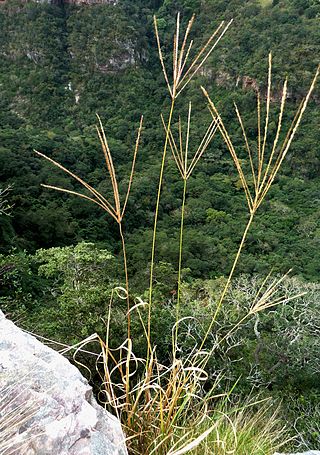
The oat, sometimes called the common oat, is a species of cereal grain grown for its seed, which is known by the same name. Oats are used for human consumption as oatmeal and rolled oats. Oats are a nutrient-rich food associated with lower blood cholesterol and reduced risk of human heart disease when consumed regularly. One of the most common uses of oats is as livestock feed.

Avena is a genus of Eurasian and African plants in the grass family. Collectively known as the oats, they include some species which have been cultivated for thousands of years as a food source for humans and livestock. They are widespread throughout Europe, Asia and northwest Africa. Several species have become naturalized in many parts of the world, and are regarded as invasive weeds where they compete with crop production. All oats have edible seeds, though they are small and hard to harvest in most species.

Andropogon gerardi, commonly known as big bluestem, is a species of tall grass native to much of the Great Plains and grassland regions of central and eastern North America. It is also known as tall bluestem, bluejoint, and turkeyfoot.

Guizotia abyssinica is an erect, stout, branched annual herb, grown for its edible oil and seed. Its cultivation originated in the Eritrean and Ethiopian highlands, and has spread to other parts of Ethiopia. Common names include noog/nug ; niger, nyger, or nyjer seed ; ramtil or ramtilla; inga seed; and blackseed.
Sativa, sativus, and sativum are Latin botanical adjectives meaning cultivated. It is often associated botanically with plants that promote good health and used to designate certain seed-grown domestic crops.

Avena sterilis is a species of grass weed whose seeds are edible. Many common names of this plant refer to the movement of its panicle in the wind.

Avena fatua is a species of grass in the oat genus. It is known as the common wild oat. This oat is native to Eurasia but it has been introduced to most of the other temperate regions of the world. It is naturalized in some areas and considered a noxious weed in others.

Lupinus luteus is known as annual yellow-lupin, European yellow lupin or yellow lupin. It is native to the Mediterranean region of Southern Europe.

Johnson grass or Johnsongrass, Sorghum halepense, is a plant in the grass family, Poaceae, native to Asia and northern Africa. The plant has been introduced to all continents except Antarctica, and most larger islands and archipelagos. It reproduces by rhizomes and seeds.

Avena nuda is a species of grass with edible seeds in the oat genus Avena.

Avena brevis, the short oat, is a species of grass in the family Poaceae whose seeds are edible.

Digitaria sanguinalis is a species of grass known by several common names, including hairy crabgrass, hairy finger-grass, large crabgrass, crab finger grass, purple crabgrass. It is one of the better-known species of the genus Digitaria, and one that is known nearly worldwide as a common weed. It is used as animal fodder, and the seeds are edible and have been used as a grain in Germany and especially Poland, where it is sometimes cultivated. This has earned it the name Polish millet.

Luffa aegyptiaca, the sponge gourd, Egyptian cucumber or Vietnamese luffa, is an annual species of vine cultivated for its fruit, native to South and Southeast Asia.

Avena barbata is a species of wild oat known by the common name slender wild oat. It has edible seeds. It is a diploidized autotetraploid grass (2n=4x=28). Its diploid ancestors are A. hirtula Lag. and A. wiestii Steud (2n=2x=14), which are considered Mediterranean and desert ecotypes, respectively, comprising a single species. A westie and A. hirtula are widespread in the Mediterranean Basin, growing in mixed stands with A. barbata, though they are difficult to tell apart.

Trisetum flavescens, the yellow oatgrass or golden oat grass, is a species of grass in the family Poaceae. It is native to Europe, Asia, and North Africa.

Setaria sphacelata is a tall African grass, also known as South African pigeon grass and African bristlegrass. It is native to tropical and subtropical Africa, and is extensively cultivated globally as a pasture grass and for cut fodder. This is a rhizomatous perennial grass producing flattened, hairless, blue-green stems up to 2 m tall. The inflorescence is a dense, narrow panicle of bristly, orange-tinged spikelets up to 25 cm long.

Piptochaetium avenaceum, commonly called black oat grass, blackseed needle grass or blackseed speargrass, is a species of perennial bunchgrass native to eastern North America. It is a member of the grass family Poaceae.

Digitaria eriantha, commonly known as digitgrass or Pangola-grass, is a grass grown in tropical and subtropical climates. It grows relatively well in various soils, but grows especially well in moist soils. It is tolerant to droughts, water lodging, suppresses weeds and grows relatively quickly after grazing. This grass demonstrates great potential for farmers in Africa in subtropical and tropical climates, mostly for livestock feed.

Brachiaria mutica is a species of grass known by the common names para grass, buffalo grass, Mauritius signal grass, pasto pare, malojilla, gramalote, parana, Carib grass, and Scotch grass. Despite its common name California grass, it does not occur in California; it is native to northern and central Africa and parts of the Middle East, where it is cultivated for fodder. It was introduced elsewhere and it is now cultivated throughout tropical regions of the world for this purpose.
Avena byzantina, red oats, is a species of cultivated oat native to Greece, Turkey, Cyprus, the Transcaucasus, Iran, and Saudi Arabia. Cultivated for thousands of years, it is better suited to warmer conditions than white or common oats, but is often sown as a no‑till winter crop. There are 564 landraces and 203 cultivars of red oats listed in the European Plant Genetic Resources Search Catalogue (EURISCO). Approximately 10% of the millions of hectares worldwide under oats are devoted to red oats, principally for fodder.


















